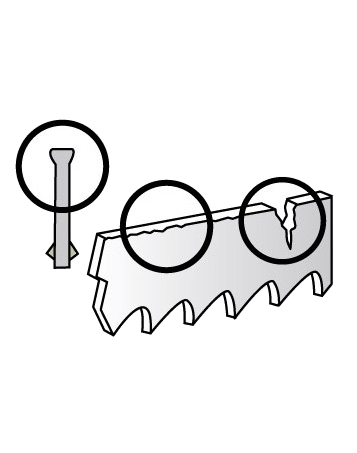
Bandsaw Back Cracking
Back cracking in bandsaw blades is a common issue often caused by excessive friction and misalignment. This can significantly shorten the lifespan of a blade and compromise the quality of cuts. There are two primary causes of back cracking in bandsaw blades:
1. Excessive Rubbing Pressure Between the Back of the Blade and the Wheels
Cause:
Excessive friction between the back of the blade and the wheels can cause significant wear on the blade over time, leading to cracks. This friction usually occurs when the wheels are improperly aligned or if the wheel tension is set too tight. Over time, this excessive pressure compromises the integrity of the blade, leading to damage.
How to Check:
To assess whether excessive friction is present, perform the following test while the blade is moving slowly:
- Method: Insert a piece of paper between the back of the blade and the top of one of the wheels.
- If the paper comes out uncut, it indicates that there is no friction, and the wheels are aligned correctly.
- If the paper is cut partially or completely, this indicates that excessive friction is occurring, and the wheels are too tight or misaligned.
Solution:
- Adjust the Wheels: If the paper test reveals that the paper is cut, it means the wheels are pressing too tightly against the blade. Adjust the wheel position to ensure there is minimal friction between the blade and the wheels.
- Check Alignment: Ensure that the wheels are correctly aligned with the blade’s path. Misalignment can cause uneven pressure, which leads to increased friction and wear on the blade. If necessary, adjust the alignment to ensure the blade moves freely without excessive rubbing against the wheels.
2. Broken Vertical Guide Bearings
Cause:
Vertical guide bearings are essential for maintaining the proper alignment of the blade during operation. If these bearings become damaged or broken, they can cause uneven pressure on the blade, particularly on its back. This misalignment results in the blade wobbling, which increases friction against the wheels and leads to further damage, including cracking.
Effect:
Damaged vertical guide bearings can cause the blade to wobble, resulting in uneven rubbing against the wheels. This increases friction and accelerates wear, which can eventually lead to the development of cracks in the blade.
Solution:
- Inspect the Guide Bearings: Regularly inspect the vertical guide bearings to ensure they are in good condition. Misalignment or wear of the bearings can lead to improper blade alignment, so it’s important to check for any issues.
- Replace Damaged Bearings: If any bearings are found to be broken or excessively worn, replace them immediately. Failing to do so will only allow the problem to worsen, leading to further damage to the blade and other components of the bandsaw.
- Lubricate the Bearings: Ensure that the guide bearings are well-lubricated to prevent friction and wear. Proper lubrication helps maintain smooth movement and extends the lifespan of the bearings.
Conclusion
Back cracking in bandsaw blades is often a result of excessive rubbing pressure between the blade and the wheels or from broken vertical guide bearings. Regular inspection and maintenance of the wheels and bearings are crucial to avoid these issues. By following the steps outlined to check for excessive friction and maintaining the guide bearings in good working condition, you can prevent damage to the blade and extend its lifespan. Regular checks and adjustments are key to ensuring optimal performance and preventing costly repairs.